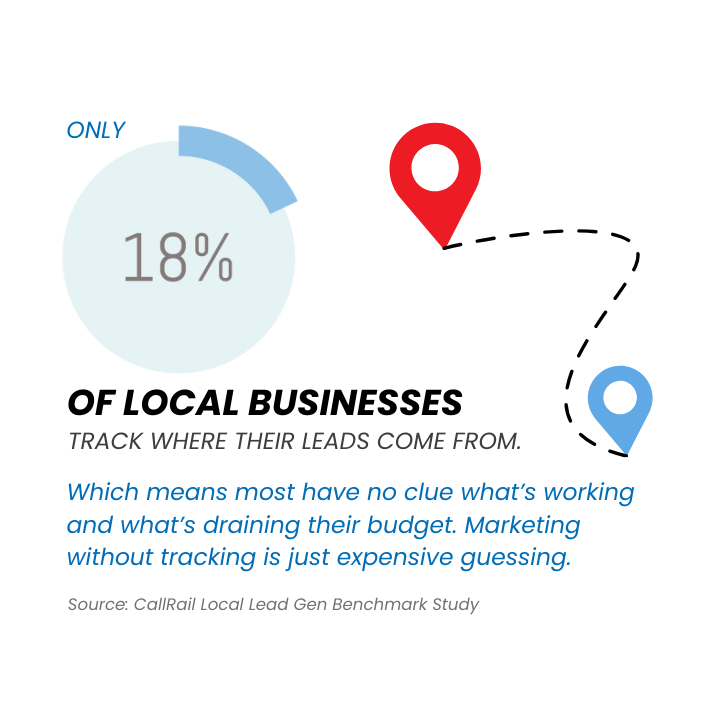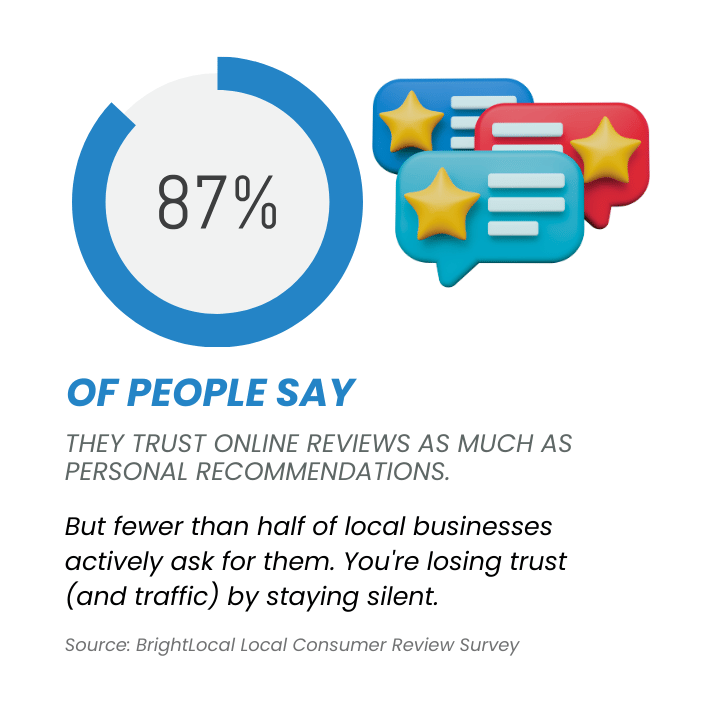Why Your Not Getting More Customers
 Sebastian Sartele
Sebastian Sartele
Your Business Should Be Busier. Here’s Why It’s Not.
Every morning, dozens of potential customers in your area wake up needing exactly what you offer. They grab their phones, search Google, and within 30 seconds, they’ve decided who gets their business.
Here’s the problem: They’re not choosing you.
While you’re working hard perfecting your craft, your competitors are capturing customers before they even know you exist. The reason isn’t your prices, your quality, or your location.
The reason is you’re invisible in the Google Map Pack.
The Google Map Pack: Where 78% of Your Customers Make Their Decision
When someone searches for your type of business, Google doesn’t show a random list. It shows the Map Pack - the 3 businesses Google trusts most in your area, displayed prominently with a map, reviews, and one-click calling.
The Eye-Opening Statistics:
93% of all local searches include a Map Pack in the results
Businesses in the Map Pack receive 93% more phone calls, website visits, and driving directions than businesses ranked 4-10
44% of all clicks go to Map Pack businesses (compared to only 8% for regular listings)
78% of customers call businesses in the top 3 Google Maps listings
68% of searchers trust Map Pack listings, compared to only 27% who trust regular organic results
Translation: If you’re not in the Map Pack, you’re missing 78% of potential customers.
Why Being #4 on Google is Like Being #400
Here’s what happens when someone searches for your service:
Position #1-3 (The Map Pack):
- Massive visibility with map display
- Prominent reviews and ratings
- One-click phone calling
- Instant directions
- 44% of all clicks
Position #4-10 (Below the Map Pack):
- Small text listings
- No visual prominence
- Buried below the fold on mobile
- Only 8% of all clicks
The brutal reality: Moving from position #4 to position #3 can triple your phone calls overnight.
The Hidden Cost of Map Pack Invisibility
Let’s calculate what being invisible is actually costing your business:
Local Market Analysis:
- Average local searches for your service per month: 500
- Customers who click on Map Pack businesses: 220 (44%)
- Customers who call Map Pack businesses: 172 (78% of clicks)
- Your current share (not in Map Pack): 8-12 calls
- Map Pack share you’re missing: 160+ calls
If your average customer value is $300:
- Monthly lost revenue: $48,000
- Annual lost revenue: $576,000
That’s over half a million dollars in business walking past your door to your competitors.
Why Traditional Marketing Can’t Compete with Map Pack Rankings
❌ Google Ads: Expensive clicks that stop when you stop paying. Only 19% of people click ads vs. 44% for Map Pack.
❌ Social Media Marketing: Takes months to build an audience. Most people don’t check Facebook when they need emergency plumbing.
❌ Website SEO: Regular listings get 2.6% click-through rate when not in Map Pack vs. 44% for Map Pack businesses.
❌ Yellow Pages/Print: Customers under 50 don’t even know these exist.
✅ Google Map Pack: Free traffic that compounds over time, highest trust and conversion rates, works 24/7.
Our Map Pack Domination System: How We Get You in the Top 3
The 5-Step Process That Gets Results:
*� Step 1: Google Business Profile Transformation We turn your basic listing into a customer magnet with strategic optimization that signals authority to Google’s algorithm.
*� Step 2: Local Authority Building We establish your business as the go-to choice in your area through strategic local signals and citations.
⭐ Step 3: Review Velocity Optimization We implement systems that generate more high-quality reviews faster than your competition, boosting your Map Pack rankings.
*� Step 4: Mobile-First Call Optimization We ensure every element of your listing is optimized for the 78% of searches that happen on mobile devices.
*� Step 5: AI-Powered Performance Tracking Our dashboard shows you exactly how Map Pack improvements translate to phone calls and revenue.
What Happens When You Dominate the Map Pack
Week 1-2: Foundation & Optimization
- Complete Google Business Profile overhaul
- Local citation building begins
- Review generation system launched
Week 3-6: Ranking Improvements
- Movement into top 5 Map Pack results
- Increased visibility for key search terms
- First wave of additional phone calls
Week 7-12: Map Pack Domination
- Consistent top 3 Map Pack positioning
- 200-400% increase in phone calls
- Market leadership established
Month 3+: Sustainable Growth
- Compound effect of all optimizations
- Customers call you first, not competitors
- Predictable stream of new business
Real Results from Real Businesses
Emergency Plumbing Service
“Went from 3-4 calls per week to 3-4 calls per day. I had to hire two more technicians and buy another truck. Map Pack ranking changed everything.”
- Mike’s Plumbing (Ranked #1 for “emergency plumber [city]”)
Family Dental Practice
“Our phone started ringing so much, we had to hire a second receptionist. New patient bookings increased 300%. Best investment we’ve ever made.”
- Dr. Sarah Chen, Family Dentistry (Ranked #2 for “dentist near me”)
Auto Repair Shop
“I’m busier than I’ve been in 20 years. Customers are driving from three towns over because they found us first on Google Maps.”
- Johnson’s Auto Repair (Ranked #1 for “auto repair [city]”)
The Science Behind Map Pack Rankings
Google’s Map Pack Algorithm Prioritizes:
1. Relevance (30%): How well your business matches what people search for 2. Distance (25%): How close you are to the searcher 3. Prominence (45%): How well-known and trusted your business is online
We optimize all three factors simultaneously:
- Relevance: Strategic keyword optimization and service categorization
- Distance: Service area optimization and local signal building
- Prominence: Review generation, citation building, and authority establishment
Why Our Map Pack System Works When Others Fail
Most SEO Companies Focus On:
- General website rankings (wrong target)
- National search terms (wrong market)
- Vanity metrics (wrong measurements)
- Technical fixes (wrong priorities)
We Focus Exclusively On:
- Map Pack positioning (where customers actually click)
- Local search dominance (your real competition)
- Phone call generation (revenue-driving metrics)
- Customer action optimization (conversion focus)
Result: Our clients see 2-5x more phone calls in 90 days.
Our Map Pack Guarantee: Results or Full Refund
Top 3 Map Pack ranking in 90 days for your primary service keyword, or you get 100% of your money back.
We can make this guarantee because:
- We’ve dominated Map Pack results for 200+ businesses
- We know exactly what Google’s algorithm rewards
- We have proprietary systems that accelerate results
- We track everything and optimize continuously
No long-term contracts. No hidden fees. Just results.
Industry-Specific Map Pack Domination
Healthcare & Medical Practices
- 92% of patients search online before choosing a provider
- Map Pack medical practices get 400% more new patient calls
- Emergency medical searches have 95% purchase intent
Home Services & Contractors
- 89% of homeowners search locally for service providers
- Emergency service calls pay 300% more than scheduled appointments
- Map Pack contractors get called first during emergencies
Restaurants & Food Services
- 78% of local restaurant searches result in visits within 24 hours
- Map Pack restaurants get 250% more weekend reservations
- Mobile food searches happen 3x more than desktop
Professional Services
- 84% of B2B buyers start with local Google searches
- Map Pack law firms get 180% more consultation requests
- Local business services have 67% higher conversion rates
The Map Pack Multiplier Effect
Month 1: Foundation established, early ranking improvements
Result: 50-100% increase in phone calls
Month 2: Map Pack positioning achieved, review momentum building
Result: 150-250% increase in phone calls
Month 3: Market dominance established, compound effects activate
Result: 200-400% increase in phone calls
Month 6+: Sustainable competitive advantage, market leadership
Result: Predictable customer acquisition system
The long-term effect: Once you dominate the Map Pack, it becomes exponentially harder for competitors to displace you.
Stop Losing Customers to Inferior Competitors
Every day you’re not in the Map Pack, your competitors get stronger while you get more frustrated. Your expertise deserves customers. Your business deserves success.
The solution is simple but not easy: Dominate the Google Map Pack.
Frequently Asked Questions
“How is this different from regular SEO?”
Regular SEO targets national rankings and website traffic. Map Pack optimization targets local rankings and phone calls. It’s a completely different algorithm with different ranking factors. That’s why general SEO companies often fail at local results.
“What if my competitors are already ranked in the Map Pack?”
Competition makes it more challenging but not impossible. We’ve displaced entrenched competitors hundreds of times. The #1 position gets 17.8% of clicks, #2 gets 15.4%, and #3 gets 15.1%. Even moving from #4 to #3 can double your calls.
“How long does it take to see results?”
Most clients see ranking improvements within 30-45 days and significant call increases by 60-90 days. Emergency service businesses often see results faster due to high search urgency.
“What if I’m in a small town with limited searches?”
Small markets are often easier to dominate because there’s less competition. Plus, local businesses in small towns often have higher customer lifetime values due to limited options and stronger community relationships.
“Do I need to understand the technical aspects?”
Not at all. We handle all the technical optimization while you focus on serving the customers we send you. You’ll get clear reports showing your ranking improvements and call increases.
Remember: In local search, you’re not competing against every business on the internet. You’re only competing for 3 spots in your local Map Pack.
Let’s make sure you win one of them.



